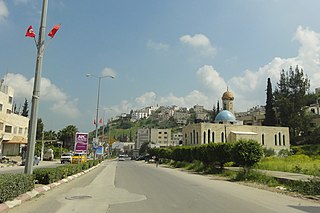
Jenin is a Palestinian city in the northern West Bank. It serves as the administrative center of the Jenin Governorate and is a major center for the surrounding towns. In 2007 the city had a population of approximately 40,000 people, whilst the Jenin refugee camp had a population of 10,000. Jenin is under the administration of the Palestinian Authority.

Haifa is the third-largest city in Israel—after Jerusalem and Tel Aviv—with a population of 285,316 in 2019. The city of Haifa forms part of the Haifa metropolitan area, the third-most populous metropolitan area in Israel. It is home to the Baháʼí Faith's Baháʼí World Centre, and is a UNESCO World Heritage Site and a destination for Baháʼí pilgrimage.

Ramla, also spelled Ramle, Ramlah, Remle and historically sometimes Rama, is a city in the Central District of Israel.

Shefa-Amr, also Shfar'am is an Arab city in the Northern District of Israel. In 2019 it had a population of 42,137, with a Sunni Muslim majority and large Christian Arab and Druze minorities.
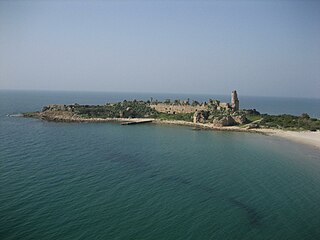
Atlit, is a coastal town located south of Haifa, Israel. The community is in the Hof HaCarmel Regional Council in the Haifa District of Israel.

Daliyat el-Karmel is a Druze town located on Mount Carmel in the Haifa District of Israel, around 20 km southeast of Haifa. In 2019 its population was 17,653.
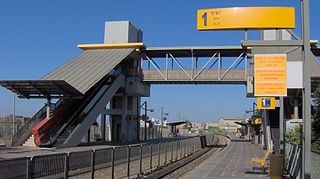
HaMifratz Central railway station is an Israeli railway passenger station in Haifa, Israel co-located with the Haifa Bay central bus station. It serves Lev HaMifratz Mall, one of Haifa's largest malls, and the surrounding Haifa Bay industrial zone in the northeast of the city.

Haifa Center HaShmona railway station is an Israel Railways passenger station situated on the coastal railway main line and serves the City of Haifa.

The German Colony was established in Ottoman Haifa in 1868 as a German Templer Colony in Palestine. It was the first of several colonies established by the group in the Holy Land. Others were founded in Sarona near Jaffa, Galilee and Jerusalem.

Balad al-Sheikh or Balad ash-Shaykh was a Palestinian Arab village located just north of Mount Carmel, 7 kilometers (4.3 mi) southeast of Haifa. Currently the town's land is located within the jurisdiction of the Israeli city, Nesher.

The Jezreel Valley railway, or the Valley Train was a railroad that existed in Ottoman and British Palestine, reconstituted as a modern railway in Israel in the 21st century. It runs from the Mediterranean coast inland along the length of the Jezreel Valley. The historical line was a segment of the longer Haifa–Dera'a Line, which was itself a branch of the larger Hejaz railway.

The history of Haifa dates back before the 3rd century BCE. Since then it has been controlled by several civilizations, including the Canaanites, Israelites, Romans, Byzantines, Arabs, Crusaders, Kurds, the Mamluks, the Ottoman Turks and the British; currently it is a major city in Israel.It is a mixed city of Jews and Arab citizens of Israel.

Ayn Ghazal was a Palestinian Arab village located 21 kilometers (13 mi) south of Haifa. Depopulated during the 1948 Arab-Israeli War as a result of an Israeli military assault during Operation Shoter, the village was then completely destroyed. Incorporated into the State of Israel, it is now mostly a forested area. The Israeli moshav of Ofer ("fawn") was established in 1950 on part of the former village's lands. Ein Ayala, a moshav established in 1949, lies just adjacent; its name being the Hebrew translation of Ayn Ghazal.

Al-Butaymat was a Palestinian Arab village the Haifa Subdistrict, located 31 kilometers (19 mi) southeast of Haifa. It was depopulated during the 1947–48 Civil War in Mandatory Palestine on May 1, 1948, under the Battle of Mishmar HaEmek.
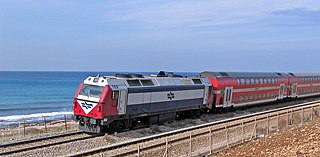
The Coastal railway line is a mainline railway in Israel, which begins just south of the Lebanon-Israel border on the Mediterranean coast, near the town of Nahariya in Northern Israel and stretches almost the entire Mediterranean coast of the country, to just north of the border with the Gaza Strip in the south.
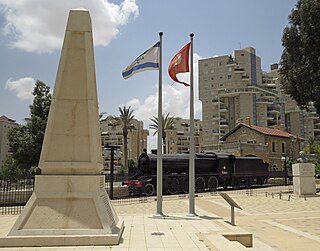
The Beersheba Turkish railway station is an Ottoman railway station in the city of Beersheba, Israel, west of the Old City.
The following is a timeline of the history of the city of Tel Aviv, Israel.
The following is a timeline of the history of the city of Jaffa, Israel.
The following is a timeline of the history of the city of Hebron, West Bank, Palestinian territories.
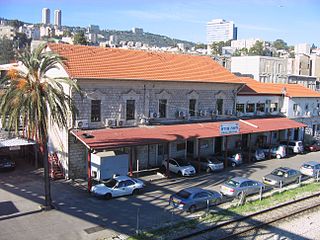
Haifa East railway station was built in 1904 by the Ottoman authorities as the western terminus of their Jezreel Valley railway. In the 1920s, under the British Mandate, Palestine Railways extended the Eastern Railway north to connect with the Jezreel Valley railway at Haifa station. At this time, Haifa was the only place in the world to have direct railway services to three continents: Istanbul in Europe, Kantarah in Africa, and Medina in Asia. To this day, the distances on the Israel Railways main line are measured from Haifa East station.

















